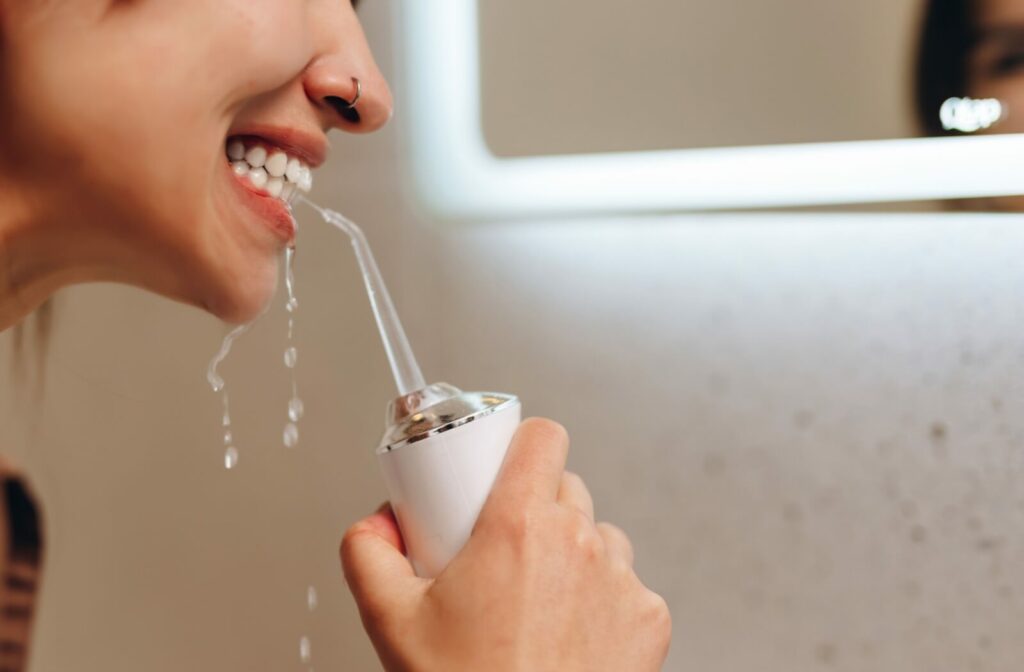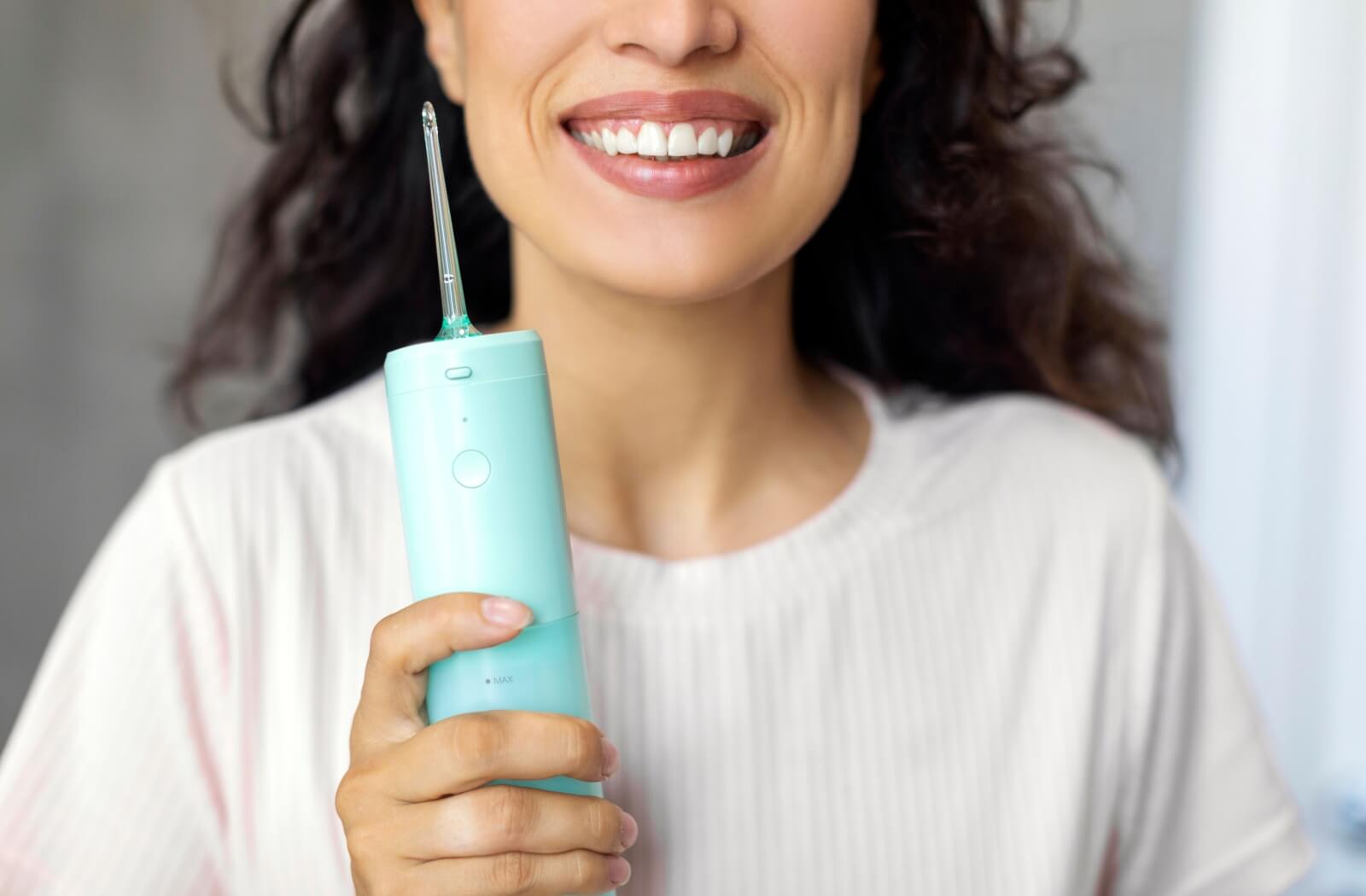Dental floss: it’s a simple tool that can effectively remove bacteria, food particles, and plaque from hard-to-reach places. It’s essential for preventative oral care. Yet, for many, making flossing a regular thing can feel challenging, inconvenient, or hard to manage.
That’s why we’re seeing a rise in alternatives. The most common alternative is the Waterpik, a water flosser that harnesses the power of pressure and pulsation to target and remove debris from hard-to-reach places gently with water.
What Is a Waterpik?
A Waterpik or a water flosser is a dental device that uses a pressurized stream of water to clean between teeth and along the gumline. While “Waterpik” is the most recognizable brand name, all oral irrigators, dental water jets, or water flossers work similarly.
Think of it as a tiny hose designed specifically for your mouth! Although simple, its technology effectively combines the power of water pressure and pulsation to gently clean and remove bacteria, plaque, and food particles between your teeth and gumline.
Here’s how the Waterpik works:
- The device sprays a targeted stream of water to dislodge food particles & debris
- The device creates a massaging motion that helps stimulate gum health
- A refillable reservoir holds water or an oral rinse & travels through a specialized tip
Traditional dental floss requires manual dexterity and precision to slide between teeth. Using a water flosser can be easier than using floss, especially for people with braces, dental bridges, or conditions that cause limited hand mobility, like arthritis.
When to Use a Waterpik
A water flosser can be a significantly beneficial option if:
- You have braces, crowns, bridges, or other dental work
- Your gums are sensitive or prone to bleeding
- You find traditional flossing difficult or uncomfortable
Other Alternatives to Traditional Dental Floss
A Waterpik is a popular alternative to traditional flossing, but it’s not the only option. If you’re looking for a thorough way to remove plaque without using standard floss or investing in a Waterpik, consider these alternatives:
- Interdental brushes resemble mini toothbrushes with bristles that help gently scrub back & forth, up & down
- The bristles can help remove plaque from tight & hard-to-reach areas, offering precise control compared to water flossers
- Floss picks are small, disposable sticks with a precut floss secured to one end and a pointy handle at the other
- Floss picks offer a convenient and effective way to remove debris while on the go

How to Use a Waterpik: Tips for Refreshing Results
Just like flossing, it’s safe to use a Waterpik at least once a day, every day!
There’s no hard rule for when to use it, but many oral health professionals recommend flossing before brushing your teeth. Flossing first helps loosen and remove lingering debris, allowing toothpaste to contact the surfaces of your teeth directly while brushing.
Following these simple steps will help you get the most out of your Waterpik:
- Fill the reservoir. Add lukewarm water or your favourite antimicrobial mouth rinse to the tank. Avoid using hot water to prevent discomfort.
- Select the right tip. Attach the tip that suits your oral health needs (e.g., orthodontic tips for braces, plaque-seeking tips for gum issues).
- Use it over the sink. Lean over the sink and close your lips slightly to avoid splashing water everywhere while still letting the water flow out. Close sink proximity helps minimize the mess!
- Start at the gums. Place the tip at a low angle to your gumline (about 90°) and activate the stream.
- Go slow and work tooth by tooth. Start at the back and move toward the front. Pause between teeth for extra cleaning.
- Adjust the pressure as needed. Begin on the lowest pressure setting and increase gradually for deeper cleaning, but stop if it feels uncomfortable.
Consistency is key to seeing visible results! So, find a time to water floss that fits seamlessly into your routine, whether in the morning or before bed. No matter how “odd” the time may feel, flossing daily can significantly support your smile now and in years to come.
Key Takeaways
Since we’ve shared lots of information with you (who knew flossing could be so thorough?), here’s a brief overview of everything we discussed concerning water flossing:
- A Waterpik can help clean tight spaces & hard-to-reach spots
- Water flossers are efficient tools for cleaning tricky areas, especially for people with dental work, gum sensitivity, or difficulty maneuvering floss
- Find a method that works for you & your oral health—or combine methods
- For ideal results & thorough cleaning, consider using a Waterpik in addition to traditional floss, or discuss your unique dental needs with your dentist
Enhance Your Oral Hygiene Routine
No matter your preferred flossing method, what matters is that you’re adopting solid habits to support your oral health!
If you’re unsure which method fits your oral health needs, connect with our Ti Dental team to schedule a routine dental exam and cleaning! A comprehensive evaluation helps your dentist tailor suggestions to meet your oral health needs.








